Welcome to our Glossary of Window Film Terms
We know that for first-time buyers of window films, there may be a some terms that are new to you. To aid our valued customers we offer the following glossary for your assistance.
If you require further clarification, we are always happy to help. Call us at (416)335-8181
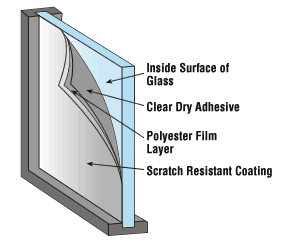 Clear Dry Adhesive (CDA)
Clear Dry Adhesive (CDA)
(‘klir · ‘drI · ad-hE-siv) n.
A mounting adhesive that uses water to activate and form a chemical bond between the glass and film, adhering the film to the glass during installation. This adhesive offers a strong bond, film clarity and longevity.
 Daylight Installation
Daylight Installation
(dA’-lIt · in’- ste-lA-shen) n.
A common method for installing solar and safety window film. Window film is precut slightly larger than the framed glass pane, then trimmed up to 1/8 inch of the glass edge.
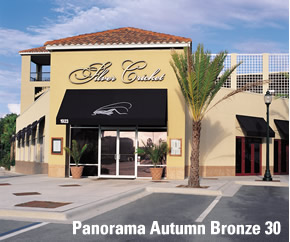 Dual Reflective
Dual Reflective
(du-el · ri –‘flek-tiv) adj.
Dual reflective window films offer reduced interior reflectance, maintaining your view though the glazing system.
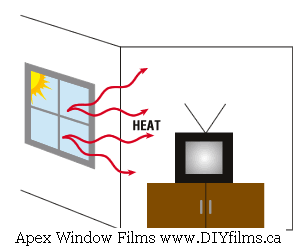 Emissivity (E)
Emissivity (E)
(e-me–‘si–ve–tE) n.
A measurement of a surface’s ability to absorb or reflect radiant energy. The lower the emissivity rating, the better the insulation characteristic of the glazing system in regard to heat loss. For windows with film, emissivity refers to the heat reflected back into the room. When using film performance data, lower emissivity ratings are preferred to minimize interior heat loss.
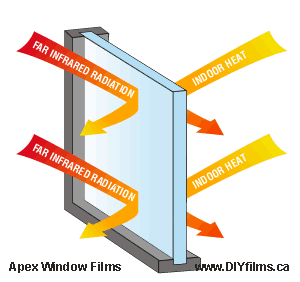 Low-Emissivity
Low-Emissivity
('lO · e-me–‘si–ve–tE) n.
Low-Emissivity, or Low-E, refers to a coating on glass or window film that reduces heat loss through the window film. The lower the emissivity rating, the better the insulation characteristic of the glazing system in regard to heat loss. Solar Gard Silver Ag 25 is an excellent low-emissivity film.
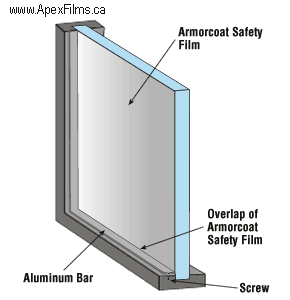 Mechanical Attachment System
Mechanical Attachment System
(mi - ‘ka - ni - kul · e-tach’-ment · sis’tem) n.
This method is used for enhanced glass retention, anchoring 8 Mil or thicker safety film to the window frame with a metal batten system. The safety film is installed to the glass, overlapping the window frame by approximately 1 inch. A metal batten system is placed over the overlapped film and screwed into the existing window frame, securely attaching the window film to the frame. Depending on the type of glass retention needed, the mechanical system can be attached as a one-sided (top), two-sided or four-sided installation.
Metallized
(me-tal-Iz-d) adj.
A process where metals are applied onto a clear, polyester film as an even layer. Different metals produce different hues and performance capabilities to meet the varying consumer needs.
MIL
(‘mil) n.
Unit of length for 1/1000 of an inch (.001”). Used in expressing thickness of films. 1 MIL = 25 microns.
Nano Ceramics
Ceramics are tough and stable materials used in space shuttles, integrated circuit components and industrial cutting tools. Nano-Ceramics are atomic-fine, equivalent to 0.000000001m discrete optical coatings which are deposited through reactive plasma processes.
 Pressure Sensitive Adhesive (PSA)
Pressure Sensitive Adhesive (PSA)
(‘pre-shur · sens-e-tev · ad-hE-siv) n.
A film mounting adhesive that uses pressure to form a mechanical bond between the film and glass, adhering the film to the glass during installation. Pressure sensitive adhesive is tacky to the touch. All automotive window films and safety window films incorporate PSA
 Safety Film
Safety Film
(saf’te · film) n.
Safety film is composed of incredibly strong, optical-quality clear or metallized polyester, high-grade ultraviolet inhibitors, special laminating and mounting adhesives, and scratch-resistant coating. The product is retrofit to interior glass surfaces for glass breakage protection. When events such as natural disasters, vandalism or bomb blasts cause glass to break, the film’s flexible construction and pressure-sensitive mounting adhesive help hold the shards on the film. This reduces the potential for personal injury and property damage. Safety film is also referred to as anti-shatter film, glass fragment retention film, blast mitigation film and Mylar.
Bekaert’s safety film is available in thickness ranging from 4 Mil (.004”) to 14 Mil (.014”) – with thicker films offering greater protection. Armorcoat is available in all thickness, offered as either a clear or metallized safety film. Select Panorama films are offered as a 4 Mil and 8 Mil upgrade.
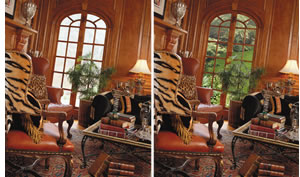 Shading Coefficient (SC)
Shading Coefficient (SC)
(shA-dEn · kO-e-‘fi–shent) n.
The ratio of solar heat gain passing through a glazing system to the solar heat gain that occurs under the same conditions if the window was made of clear, unshaded double strength glass. The lower the SC number, the better the solar control efficiency of the glazing system.
 Solar Absorptance (A)
Solar Absorptance (A)
(sO-ler • ab-‘zorp–tens) n.
The amount of solar energy (visible, infrared and ultraviolet,) that is absorbed by the glazing system, expressed as percent.
When sunlight strikes glass, solar energy is either transmitted through the glass, absorbed by the glass or reflected away from the glass. The type of glass and window film applied causes varying absorptance results, expressed as a percent – this is the amount of solar energy that the glass and film retains. Always refer to a manufacturer’s film-to-glass installation recommendation.
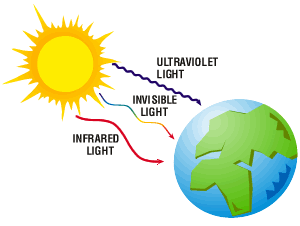 Solar Energy
Solar Energy
(sO–ler · e-ner–jE) n.
Energy from the sun that is represented by visible light (glare), infrared radiation (heat) and ultraviolet radiation (fading and health hazards). Each form of energy is differentiated by its wavelength.
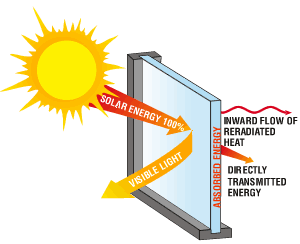 Solar Heat Gain Coefficient (SHGC)
Solar Heat Gain Coefficient (SHGC)
(sO-ler · hEt · ‘gAn · kO-e–‘fi–shent) n.
The percentage of solar energy directly transmitted or absorbed and re-radiated into a building. The lower the SHGC, the better the solar control properties of the film.
 Solar Reflectance (R)
Solar Reflectance (R)
(sO-ler • ri- ‘flek–tans) n.
The amount of solar energy (visible, infrared and ultraviolet) that is reflected by the glazing system, expressed as a percent.
When sunlight strikes glass solar energy is either transmitted through the pane of glass, absorbed by the glass or reflected away from the glass. The type of glass and window film applied causes varying reflectance results, shown as a percent – this is the amount of solar energy that the glass and film rejects away.
For maximum heat rejection, look for films with a high solar energy reflectance rating. Always refer to a manufacturer’s film-to-glass installation recommendation.
 Solar Transmittance (T)
Solar Transmittance (T)
(sO–ler ·tranz–‘mi-tens) n.
The amount of solar energy (visible, infrared and ultraviolet) that passes through a glazing system, expressed as a percent.
When sunlight strikes glass, solar energy is either transmitted through the pane of glass, absorbed by the glass or reflected away from the glass. The type of glass and window film applied causes varying transmittance results, shown as a percent – this is the amount of solar energy that entered through the glass and film. Always refer to a manufacturer’s film-to-glass installation recommendation.
 Spectrally Selective
Spectrally Selective
(‘spek-tral-lE · se-‘lek-tiv) adj.
Spectrally selective window films block only select wavelengths of radiation while maintaining a high amount of visible light transmittance. These premium films keep out the heat you don’t want and let in the natural light you love.
The Panorama Hilite and Sterling series allow for a luminous interior, while ensuring a comfortable and temperate environment. These films are the most subtle, practically invisible when installed - ideal for maintaining a perfect view, and comfortable. even climate.
Sputtering
(‘spu-tur-ing) v.
A process that imbeds metal particles such as silver, stainless steel, copper, gold, titanium and chromium onto polyester film. Rolls of film are unwound and passed over target materials, depositing atoms evenly on the surface of the film through ion bombardment. This ensures long-lasting color and excellent solar performance. BSF was the first in the industry to sputter-coat window film.
 Total Solar Energy Rejected (TSER)
Total Solar Energy Rejected (TSER)
(to-tel · sO-ler · e-ner-jE · ri– ‘jekt–ed) n.
Measures the window film’s ability to reject solar energy in the form of visible light, infrared radiation and ultraviolet light. The higher the TSER number, the more solar energy is rejected way from the window.
 U-Value
U-Value
(‘yU–‘val–‘yU) n.
A measurement of heat transfer through film due to outdoor/indoor temperature differences. The lower the U-value, the less heat transfers. When using performance data, a lower U-value is desirable for heat management.
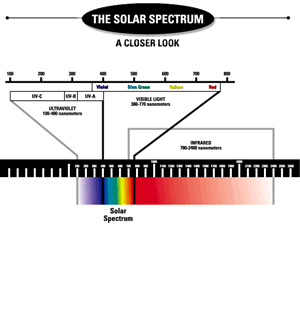 Ultraviolet Light (UV)
Ultraviolet Light (UV)
(‘ul–tra–‘vI–yo-let · ‘lIt) n.
Invisible, powerful wavelengths (shorter than light but longer than X rays) emitted by the sun separated into three types, UV-A, UV-B and UV-C. UV-B causes sunburn, and prolonged exposure can cause skin cancer. Window films block nearly 100% of ultraviolet light from passing through glass. The Panorama window films are approved products of the Skin Cancer Foundation.
Visible Light Absorptance (VLA)
(‘vi-ze-bel · lIt · ab-‘zorp–tens) n
The amount of visible light that is absorbed by the glazing system, expressed as a percent.
Visible Light Reflectance (VLR)
(‘vi-ze-bel · lIt · ri- ‘flek–tans ) n
The amount of visible light that is reflected by the glazing system, expressed as a percent. A higher VLR rating offers better glare control. Films with higher ratings tend to be more reflective and/or darker.
Visible Light Transmittance (VLT)
(‘vi-ze-bel · lIt · tranz–‘mi-tens) n.
The amount of visible light that passes through the glazing system, expressed as a percent. A lower VLT rating tends to be better for glare control, while a higher rating is preferred for maintaining natural light.
